Knives - Care, Maintenance and Related Utensils
With the right care, they last a lifetime
Good quality knives don’t come cheap. But you have to bear in mind that, if well looked after, they will last a lifetime.
I have several knives, of different types, national and imported, which have been with me for over 19 years and are as good as new.
Care to be taken
- Use your knife on soft surfaces such as wooden boards or polyethylene. Never use on glass or metal surfaces. The edge will run out quickly.
- Use your knives for what they were designed for. Don’t try to break bones with fillet knives, for example.
- When you are using your knife and need to rest it on the board, make sure it rests on the top of the board with the edge sticking out. This way, you don’t risk hitting the edge with your hand and cutting it, ruining your kitchen party.
Example of correct knife positioning in the picture below:
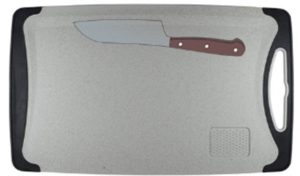
When using the knife, don’t gesticulate with it.
- If you give someone a knife, always turn the handle towards the person and the edge downwards. This will prevent serious accidents.
- Every time you finish using it, wash and dry it. If the knife is made of carbon steel or damascus steel, you will need to apply a layer of oil.
- Put it away as soon as it has dried. If you leave it in a colander, the other utensils could damage the edge and you’ll need to sharpen it.
- The recommendation to put it away is even more important for those who, like me, have children at home. Take care of their safety.
- Keep your knife sharp. Dull knives are dangerous.
Maintenance of a knife
Maintaining a knife doesn’t require much work.
As I mentioned above, carbon steel and damascus steel knives require more care when it comes to rust protection.
Keeping them clean, dry and ventilated is what they need to have a long, rust-free life.
However, something that is of fundamental importance is the maintenance of the edge.
Bear in mind that a dull knife is dangerous because you have to use more force to make the necessary cuts. Using more force means you have less control.
A sharp knife, on the other hand, makes a precise and effortless cut.
Maintenance of the knife edge
There are two basic techniques for maintaining the knife edge: aligning the edge or creating a new edge. The choice depends on the condition of the blade.
This is a very long subject, but I’ll talk about it briefly because this ebook is about tools and not sharpening techniques.
There is a lot of information on the subject on the internet and I will write a full blog post in due course.
As you use your knife, its edge will be required and basically three things can happen to it:
- Misalign
- “Blind
- Create a hole in the knife edge if you hit a hard corner
In everyday life, the misalignment of the edge happens naturally. The edge bends sideways. In this case, we don’t sharpen the knife, i.e. we don’t use a sharpening stone; it’s only used in cases of a “dull” knife, with a blunt edge
To align the edge, we use a knife sharpener rod or a honing steel knife sharpening.
There are 3 types of blades:
- Grooved
- Diamond
- Ceramic
Carbon Steel Black Knife Sharpening
It is used to realign the edge of the blade, which, as I said before, bends with use.

Carbon Steel Black Knife Sharpening
Use it whenever you are starting work or when you feel that the wire is “crushing” the ingredient and not cutting it easily.
The safest way to use the knife is to hold it firmly and rest the tip of the knife on a firm surface, such as your chopping board.
Once this is done, place the edge of the knife against the flat iron at an angle of approximately 10 to 15 degrees.
The angle varies depending on the type of knife.
In a downward motion, run the entire blade of the knife along the body of the knife.
Perform this movement about 5 times on each side of the blade.
Test the knife on a sheet of paper or a tomato, which has a skin that is very resistant to cutting.
If you feel that the knife glides and cuts easily, congratulations, your knife is ready for use.
Wash it before cutting the food to remove any metal residue.
Otherwise, do the same motion a few more times.
If that doesn’t do the trick, you’ll need to sharpen the knife using a sharpener or sharpening stone.
The process is different for Yanagi-type knives (sushi/sashimi).
Look up the sharpening process for sushi knives on the internet.
If the use of the Steel Kinfe Sharpening was not enough to get your knife cutting properly again, then we must use other techniques.
Diamond Carbon Steel Knife Sharpener Rod
Diamond carbon steel knife sharpening have great abrasive power and, when used, remove material from the blade, creating the cutting edge.
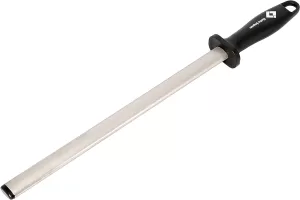
Diamond Carbon Steel Professional Knife Sharpener Rod
Ceramic Rod Knife Honing
Ceramic Rod Knife Honing have a high abrasive power, but less than diamond tongs and when used, they also remove material from the blade, but create a more delicate edge.
Keep in mind that ceramic utensils do not withstand falls well.
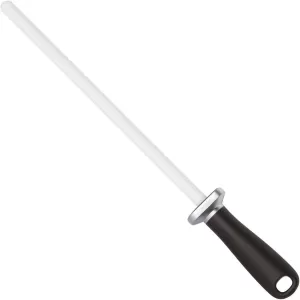
White Ceramic Knife Sharpener Honing Rod
Sharpening Stone
When a knife has reached the point where it no longer has an edge, the best way to restore it is to use sharpening stones.
The stones have different degrees of roughness, many are double-sided, so you start the sharpening process on the more abrasive side and finish on the less abrasive side.
Depending on the quality of the knife and the purpose, you can pass the knife through 3 or more stones with different degrees of abrasion to obtain a perfect finish.
In the case of sushi/sashimi knives, for example, the sharpening process is very careful in order to obtain the best possible result.
At home we can use a stone with a 1000 degree of abrasion, which will be more than enough.
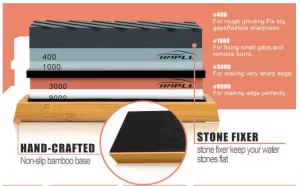
You’ll find lots of videos on the internet on this subject. I’ll record a video with all the details in due course.
Hand-held knife sharpener
Another way to sharpen a knife is to use a sharpener, like the one below.
The work won’t be as perfect but it works for more basic use.
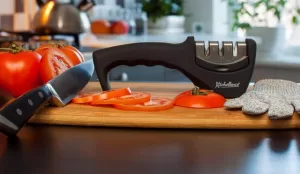
Knife Edge Guard
I like to store my knives away from other utensils and put plastic covers or sheaths on them to protect the edge and our hands.
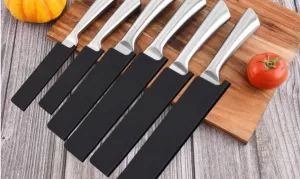
“We participate in the Amazon Associates Program, an intermediary service between Amazon and customers, which remunerates the inclusion of links to the Amazon site and affiliate sites..”
See also:
– Knives: A type for every purpose
– Knives: The queens of the kitchen
– Damascus Steel in Kitchen Utensils: Art and Efficiency in Harmony
– Click here to get a free “30 Basic Utensils” ebook